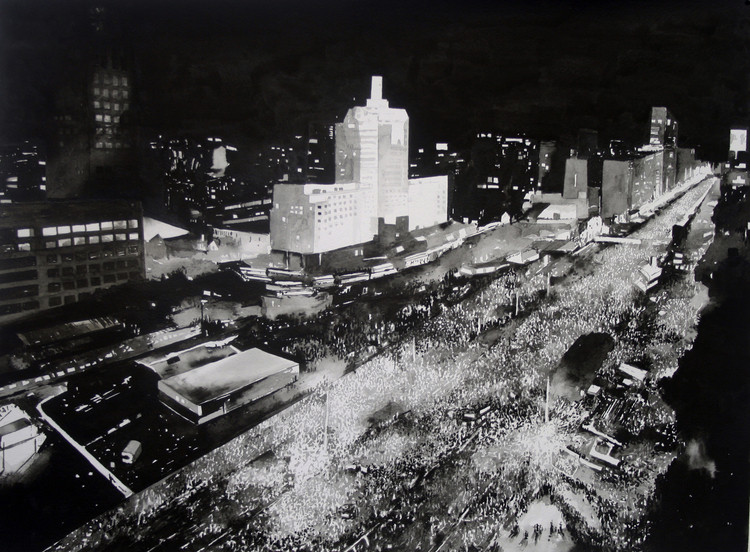Joy Gerrard
08 Oct - 28 Nov 2015
JOY GERRARD
Protest Crowd
8 October - 28 November 2015
People coming together – en masse – has a rich potency that can be both compelling and unsettling, whether witnessed as a spectator or experienced as ‘one of the crowd’. Crowds assemble or congregate in large, defined central urban communal spaces like squares, plazas, or parks to celebrate, commemorate as well as demonstrate. Crowds are places to hide in and can offer a platform for expression ranging from freedom to fear. The crowd is singular, but it denotes a multitude of individuals who have gathered to express a unified voice. Crowd is both noun and verb.
The primary focus of Joy Gerrard’s work in recent years has been the depiction of crowds. She makes small monochrome drawings, and more recently large paintings, of dense crowd scenes taken from newspaper and online images of mass urban protest. Viewed from above, from tall buildings or from news helicopters, Gerrard’s images present a topographical view of hordes of people contained within or spilling out of huge civic spaces in a kind of calligraphic active groundswell. Hundreds of intense, tiny brush marks draw the viewer into particular incident within the works, but equally, they are immediately recognisable – being derived from powerful images that have proliferated via the mass media of the Arab Spring, the Occupy movement, mass actions across European cities, US inner city demonstrations and many others. These are all part of our recent history.
We read these works as both abstract and figurative – spectacle and event. For Gerrard, this tension between what is depicted and the physical making of the work is held constantly at play. What drives the work is an enquiry into the relationship between the built environment and the right to assembly, as both protest and individual expression; “The image comes from a real moment in time, in a real place, when thousands came together to protest at an injustice or an entire regime, or the railing against the taking of a single life.” But ultimately, the work emerges from a series of minute decisions made about mark making and composition; “The tonal balance often has no relation to the original photographic image... the image will not function until this is correct.”
Protest Crowd
8 October - 28 November 2015
People coming together – en masse – has a rich potency that can be both compelling and unsettling, whether witnessed as a spectator or experienced as ‘one of the crowd’. Crowds assemble or congregate in large, defined central urban communal spaces like squares, plazas, or parks to celebrate, commemorate as well as demonstrate. Crowds are places to hide in and can offer a platform for expression ranging from freedom to fear. The crowd is singular, but it denotes a multitude of individuals who have gathered to express a unified voice. Crowd is both noun and verb.
The primary focus of Joy Gerrard’s work in recent years has been the depiction of crowds. She makes small monochrome drawings, and more recently large paintings, of dense crowd scenes taken from newspaper and online images of mass urban protest. Viewed from above, from tall buildings or from news helicopters, Gerrard’s images present a topographical view of hordes of people contained within or spilling out of huge civic spaces in a kind of calligraphic active groundswell. Hundreds of intense, tiny brush marks draw the viewer into particular incident within the works, but equally, they are immediately recognisable – being derived from powerful images that have proliferated via the mass media of the Arab Spring, the Occupy movement, mass actions across European cities, US inner city demonstrations and many others. These are all part of our recent history.
We read these works as both abstract and figurative – spectacle and event. For Gerrard, this tension between what is depicted and the physical making of the work is held constantly at play. What drives the work is an enquiry into the relationship between the built environment and the right to assembly, as both protest and individual expression; “The image comes from a real moment in time, in a real place, when thousands came together to protest at an injustice or an entire regime, or the railing against the taking of a single life.” But ultimately, the work emerges from a series of minute decisions made about mark making and composition; “The tonal balance often has no relation to the original photographic image... the image will not function until this is correct.”

